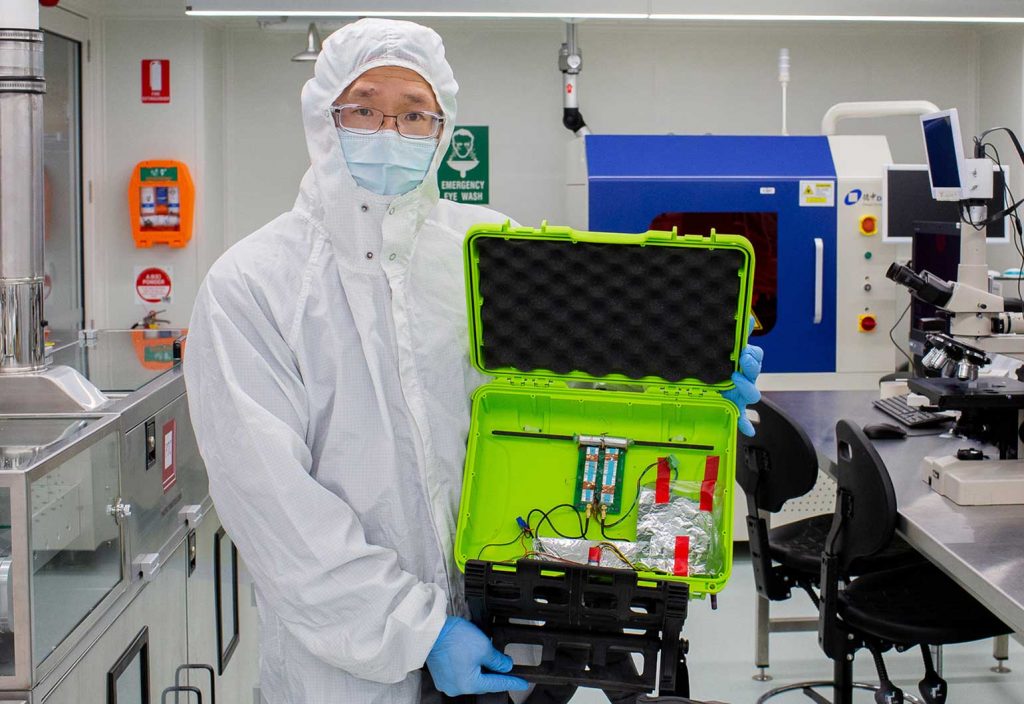A miniature device that can scan deep below ground to identify ice deposits and hollow lava tubes on the Moon has been co-developed by RMIT researchers in Melbourne and Canadian company International Groundradar Consulting.
The prototype device, known as MAPrad, is one-tenth the size of existing ground-penetrating radar systems, yet can see almost twice as deeply below ground — more than 100 m down.
Local start-up CD3D PTY Ltd, headed by geophysicist and RMIT Honorary Professor James Macnae, has received a grant from the Australian Space Agency’s Moon to Mars initiative to further develop the prototype with an expert university team that includes aeronautical engineer Graham Dorrington.
Macnae said the unique geophysical sensor had several advantages over existing technologies that made it more suitable for space missions, including being lighter, more sensitive and able to penetrate more deeply.
Dorrington, who will ensure the prototype is robust enough for lunar surfaces, said the system could be mounted on a space rover, or even attached to a spacecraft in low orbit.
From a radio antenna to a space-age device
The magnetic waves emitted and detected by the device measure conductivity and electromagnetic wave reflections to identify what lies underground.
Voids and water-ice provide strong reflections, while various metal deposits have high conductivity at unique levels.
Macnae said the team used novel nanotechnology to engineer a more sensitive and lower noise detector based on the same physical principles as an AM radio magnetic field antenna.
This included almost completely eliminating common-mode electric and magnetic signals that are a limitation in conventional radar systems.
“The transmitter needs the same power to radiate signals, so the new system needs the same power as existing technology, but the magnetic antenna we built has much lower noise than a receiver antenna, and therefore sees deeper,” Macnae said.
“This is partly because the electric antennas need to be on the ground to work well and are subject to electrostatic noise while being dragged along.“
The reduced weight comes from shorter antenna, resulting in smaller packaging and recent electronic advances shrinking circuitry, while a frequency of 30 MHz or less was used for deep penetrating radar.
Pre-lunar testing
MAPrad’s initial development was specifically focused on facilitating drone surveys for mining applications.
To further prove the technology’s usefulness for a range of Moon missions, the researchers will seek permission to scan one the world’s largest accessible systems of lava tubes at Undara caves in Far North Queensland.
Dorrington said the RMIT team would like to traverse the park above the caves to detect the voids below, some of which have not yet been completely mapped.
“Undara will be an excellent testing site for us, since it’s the closest thing on Earth to the lava tubes thought to exist on the Moon and Mars,” he said.
The exact structure or function of the lunar tubes is still unclear but is of enormous scientific interest, Dorrington said.
“Of more immediate concern is mapping subsurface water ice on the Moon and getting a clearer picture of the resources available there to support life and space infrastructure,” he added.
One more step for mankind
Next on the agenda for the RMIT team is optimising the device so it will not interfere or interact with a space rover or spacecraft’s metal components, or cause incompatible electromagnetic interference with communications or other instruments.
“Looking at its ability to withstand extreme temperature changes, vibration or cosmic ray bombardment will also be key,” Dorrington said.
“We are also involved in discussion with spacecraft integrators who will carry instruments such as this.”
Potential commercial applications were similar to deep penetrating conventional radars, Macnae said. This includes searching for subsurface voids prior to suburban development, looking for clandestine tunnels, tracking leakage from tailings dams (predicting dam failure) and mineral exploration.
However, the device is unlikely to replace concrete or civil engineering radars where gigahertz signals only require electric antennas a few centimetres long at most, and targets such as rebar are very close, he said.
